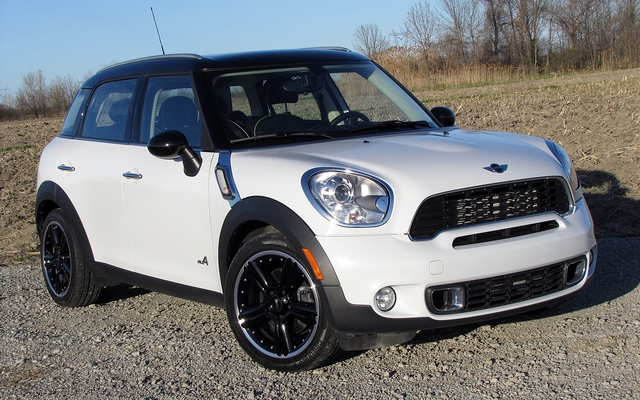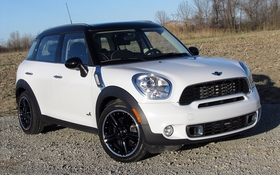2011 Mini Countryman – More macho, roomier and.... less appealing

| Strong points |
|
|---|---|
| Weak points |
|
The legendary Mini’s renaissance in 2002 was an unmitigated success thanks to enormous revenues and its new owner’s – BMW – exceptional talent for design and engineering. Since the resounding success of the new Cooper and Cooper S, focus and a concerted effort has seemed to be lacking at this brand, which is now as much German as it is British.
The first modern Mini hatchbacks were joined by a pair of convertibles in 2005 and all four models were completely redesigned two years later. Last year, Mini brought the Clubman back to life, a miniature wagon equipped with a par of vertical doors for the cargo hold and a half-door on the right side to facilitate access to the backseats. And it works, especially considering that the Clubman’s wheelbase is 80 mm longer and the seats all the more roomy.
But it still wasn’t enough to satisfy the maxi ambitions of the Mini brand. The Countryman Cooper and Cooper S are longer, wider and taller than the Clubman and built on a wheelbase that’s 49 mm longer. What is the point of making an even bigger version of the car that proved that cars can be both miniscule and practical? In fact, the Countryman was created to broaden the product line and offer more room, but also to produce the first Minis with all-wheel drive.
Familiar designs
The Countryman’s affiliation with the Mini brand is instantly recognizable, but their shape certainly doesn’t have the elegance of the hatchback models. More curvaceous and with a raised profile: they’re like work boots; the other models are more like running shoes. The Countryman Cooper S can be recognized by its front grille’s additional air intakes, it’s more sculpted tail end, its twin exhaust and its wheels that are larger than those of the Cooper version.
In the Mini tradition, the dashboard has an immense round indicator dial dead centre where you find the speedometer on the outside and the display screen in the middle. You navigate between the menus using a joystick-style lever and two buttons located on the console on the floor. It’s Mini’s version of BMW’s iDrive interface, and it demands a certain period of adaptation. You already have to decode a series of buttons that decorate the central console, including chrome switches for the windshield wipers and the door locks.
This isn’t easy to do at first. I had to search for the controls for the audio system, but I really like the telephone features. For once, I even managed to connect my modest cellular easily to a German-designed product, which is no small feat consider that many brands turn their noses up at anything that isn’t an iPhone or Blackberry.
The leather-covered steering wheel is just about perfect and the cruise controls and audio system commands are impeccable. There’s a large rev counter with a white background dead ahead, plus aluminum pedals and a good footrest. A good driving position is easy to find and the visibility is great, except for a very wide central upright on the left side that surely makes the body stronger, but creates a huge blind spots. The right rear-view mirror is mounted too low causing you lose a good fifth of its surface from the driving position.
I’m not sure about the large handle on the parking brake either. It looks more like what you’d find in a truck than the traditional stick shift, and maybe that’s what the designers were going for to highlight this new series more macho side. The problem is that the movement is unnatural and it’s hardly logical for a control that you have to activate in a fraction of a second.
Access to the backseats is very good and they turn out to be very comfortable, although at first glance you’ll be rather sceptical. These two seat cushions have a rounded shape reminiscent of the Mini ignition key, which looks like a saucer. There’s enough room for all body parts in back, including the feet under the front seats.
There’s also a 13-cm longitudinal setting for the back seats that helps better divide the space between the passengers and the cargo behind them. You can also move two cupholders, a case for sunglasses and a place to put your telephone on two aluminum rails. The baggage hold is saved by a 25 or 30 cm-deep compartment in the floor and you can also fold down the seatbacks.
A chip off the old block
The Countryman Cooper S ALL4 is lively and agile in turns thanks to the good geometry of its front end and precise, well-assisted steering. It’s balanced, demonstrates very little roll and holds the road with tenacity: the stuff of a true Mini. However, it has the maddening trait of following ruts in the road like a retriever.
The Coopers S that we test drove came equipped with the Sport Package, which gives it a firmer suspension and 225-45R18-size Pirelli P7 performance tires on shiny black alloy wheels. The Cooper version was fitted with the regular version of the same kind of tires, but in the 205/55R17 size. The directional stability was somewhat unreliable, sensitive to crosswinds and relatively noisy, both from the wind and from the ride itself.
The ride was always very firm in this Cooper S, but it banged very hard in the slightest pothole, which is a common fault of many of the series made by BMW and Mini. And it’s not just the more rigid sides of the run-flat tires that the manufacturer is using on a lot of models that are to blame.
The 1.6-litre four-cylinder naturally-aspirated engine in the Cooper Countryman produces 121 horses at 6,000 rpm and 114 lbs-ft of torque at 4,250 rpm. The turbocharged version of the same engine sends 181 horses at 6,000 rpm and 177 lbs-ft of torque at 1,600 rpm to the Cooper S ALL4’s all-wheel drive.
A manual gearbox and a turbo engine make quite the team in the Cooper S and offers generous torque in low gear. Nevertheless, it’s very easy to stall the engine when starting because the flywheel is very light, undoubtedly to make sure that it remains responsive and to keep the little engine revving. The rather harsh clutch doesn’t exactly help the matter.
The laws of physics
You don’t feel any torque steer when accelerating with the ALL4 model, no doubt thanks to the all-wheel drive. The Cooper’s turbo boosts at 2,500 rpm are finally under control. The ALL4 went from 0-100 km/hr in 9.03 seconds and did the quarter-mile in 16.67 seconds with a maximum speed of 138.2 km/hr. Obviously, that’s slower than Mini’s official times and than the 7.87 and 15.62 seconds of the Cooper S Clubman in the same tests, but it’s 110 kilos lighter.
The Countryman Cooper performances are more moderate, with a 0-100 in 11.89 seconds and the ¼ mile in 18.19 seconds with a maximum speed of 123.9 km/hr. In emergency braking at 100 km/hr, the Cooper S and Cooper stop in a very average 39.64 and 44.24 metres. The S’ braking is much more powerful thanks to larger front discs (307 mm versus 294 mm) and the Sport Package’s performance tires. Despite the fact that the Cooper’s tires bear the same name, they demonstrated average grip.
The 6-speed manual gearbox is typical of Mini, with a large knob of the stick shift, decent control and precision, and easy suspension travel. However, the trigger that protects the reverse from first gear on the stick is too weak and you can find yourself in reverse if you’re not careful. Imagine how surprised the driver behind you will be when the light turns green...
I wasn’t crazy about the Countryman’s look at first and I remained truly confused when I saw the first photos of the version created for the World Rally Championship. Moreover, since I saw and heard the Mini in action driven by the Spanish team of Dani Sordo and Carlos Del Barrio en route to its first podium at the Rallye Deutschland, I couldn’t wait to see a standard Countryman ALL4 inspired by this car. It’s just the sort of thing needed to get under the skin of the likes of the Mitsubishi Evo and Subaru STI and to finally give this atypical Mini a unique personality.
For the moment, the Countryman is for those who can live with the paradox of a bigger, heavier, slower and less fuel efficient Mini that is simultaneously roomier and available in four-wheel drive...if you pay the price.











